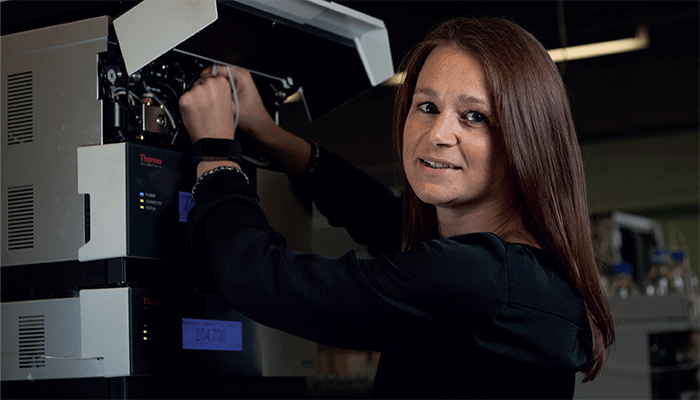A conversation between Deirdre Cabooter and Gert Desmet
Gert Desmet: It’s not correct to say that the van Deemter equation is dogma. Quite the reverse – the plate height curve described by the equation actually helps undermine dogmatic practices in the field. For example, why do people persist in running proteomic separations at 300 nL per minute? We know this flow rate is not necessarily the best for mass spectrometry, and we now have columns designed to operate at velocities from 50 to 1000 nL per minute. But because the original proteomics studies, from the 1990s, specified 300 nL per minute, it’s stuck – people just keep repeating the original method! The same mindset is at work when people replace a 4.6 mm column with a 2.1 mm column, but neglect to adjust the flow settings. Inevitably, they get pressure errors, and the separation doesn’t work as expected. If operators were more familiar with the van Deemter curve, they would understand how to optimize flow rates for each specific separation set-up. Because that’s what the van Deemter does – it defines optimal flow rates.


Deirdre Cabooter: It’s the basis of everything in separation sciences. If you are not familiar with the van Deemter equation, you won’t get the most out of your instruments. It’s like having a Ferrari, but never moving out of first gear. You have the capacity but you have no idea how to use it.
Gert: And using an advanced column in the wrong way, in the wrong set-up, is like putting a Ferrari engine in a Volkswagen Beetle – it’s just not optimal! In the same way, when people try separating a large molecule using flow rates designed for small molecules, their process won’t be efficient, because – as van Deemter shows us – the optimum velocity is much lower for larger molecules.
Deirdre: Exactly – the nature of the compound you are studying will affect optimal system parameters. And because the optimum flow rate is not the same for all molecules, there’s not just one plate height curve – there are many, according to the analyte and the conditions it needs. Most chemistry MSc courses, however, just show the textbook van Deemter curve; students are never told that the shape of the curve depends on the analyte and the mobile phase. It’s not put in context.
Gert: And the results of that uncontextualized, imperfect understanding can be unfortunate. At the least, it can result in operators wasting a lot of time and money in trial-and-error method development. More seriously, consider a situation where somebody new takes over an established quality control method. They see an error message, so they put in a new column, the first they across. If this column has a different particle size and they don’t adjust the system settings, the system would no longer be working at the optimal flow rate. And this might result in impurities slipping under the main peak, so they don’t get noticed. This can be critically dangerous, and is a very good reason for operators to ensure they are familiar with the practical implications of the van Deemter equation.
Deirdre: Importantly, the van Deemter equation not only allows us to define the optimum conditions for a given process, but also to understand why they are optimal. Fundamentally, it shows the effect of flow rates and particle size – two important variables in method development. Once the chemistry has been optimized, people want to speed up the method, and that must be done with reference to van Deemter. Otherwise, processes will be inefficient, and possibly inadequate. Unfortunately, there is now a lack of separation scientists who are truly familiar with basic principles, which means that industry is sometimes forced to recruit from other disciplines. But these workers are not equipped to rigorously analyze the separation problem, and so may unthinkingly follow existing procedures – which is when things can go horribly wrong. So we really need to get students to understand the importance of the van Deemter equation – it’s hugely important; for example, it helps people make cost-effective purchasing decisions rather than being persuaded to buy column technology they don’t need.
Gert: In my classes, I illustrate the van Deemter impact with computer animations. I give students a model situation, and ask them to improve the process by altering variables like particle size and pressure. Of course, it would be ideal if each student could modulate settings physically rather than virtually, via access to a real instrument, because learning through experience is best. Unfortunately, this approach is unaffordable with large classes, so visualization tools are the most realistic option. For example, to explain the physics behind van Deemter, I use the analogy of a series of mixing units; in each unit, a molecule has a probability of remaining in the unit or leaving for the next one. The more units per length you have, the narrower the distribution in residence time eventually becomes. The larger the units, the more time it takes for a molecule to leave and hence the larger the plate height becomes. Overall, my experience is that computer animations really aid understanding, especially for the current generation of students. And there are some very useful chromatogram simulators on the internet.
Deirdre: That’s a good point – I have seen excellent animated tools in other fields, including videos that illustrate convolutional neural networks and other complex systems. Why don’t we construct similar kinds of visual concepts for the van Deemter equation?
Gert: Yes! In fact, we could integrate this approach into teaching – we could ask the students themselves to make a short video clip wherein they demonstrate one of the core principles. Instead of just providing them with a computer animation, we give them an assignment that requires them to make one! That would play to the strengths of today’s students, while at the same time helping them grasp the fundamental importance and significance of the van Deemter equation – to the great benefit of both the students and the industry that will employ them. Watch this space!
Gert Desmet is a Full Professor and Department Head, Vrije Universiteit Brussel; and Deirdre Cabooter is a Professor, University of Leuven, Belgium




